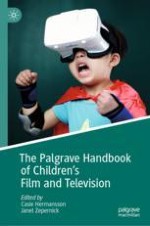2019 | OriginalPaper | Chapter
13. Entering the Labyrinth of Ethics in Guillermo del Toro’s El laberinto del fauno
Author : Evy Varsamopoulou
Published in: The Palgrave Handbook of Children's Film and Television
Publisher: Springer International Publishing
Activate our intelligent search to find suitable subject content or patents.
Select sections of text to find matching patents with Artificial Intelligence. powered by
Select sections of text to find additional relevant content using AI-assisted search. powered by
